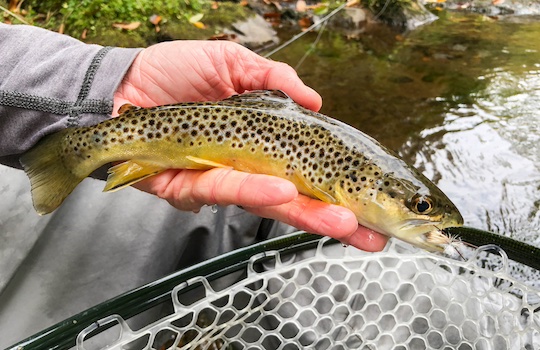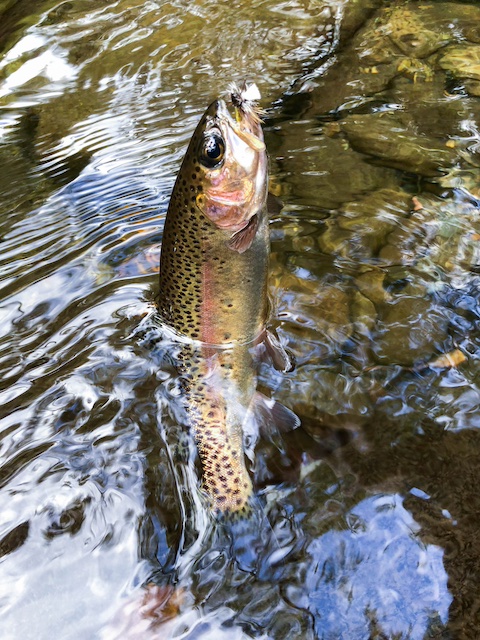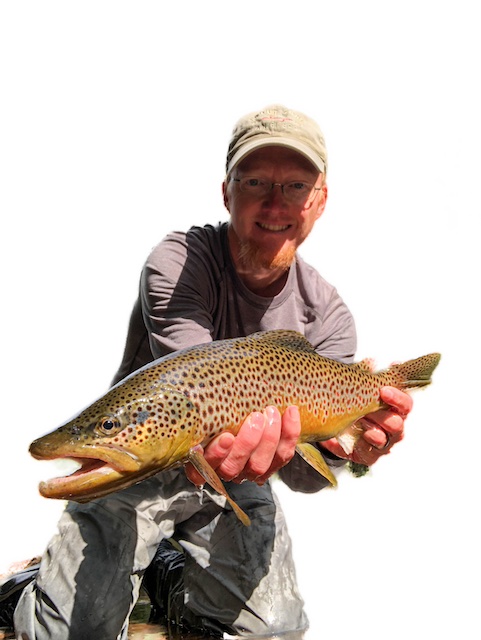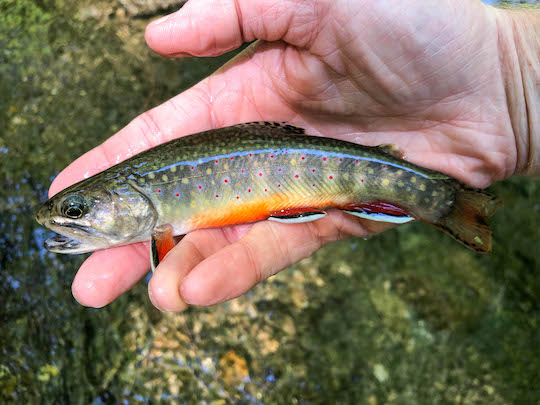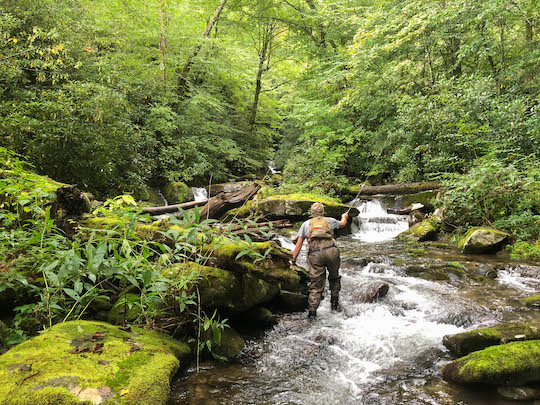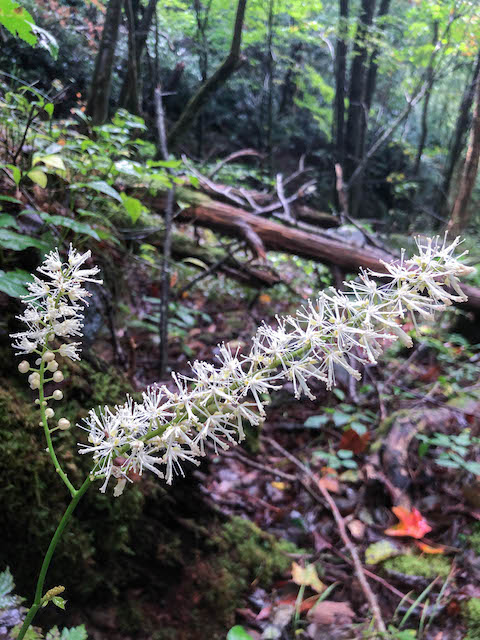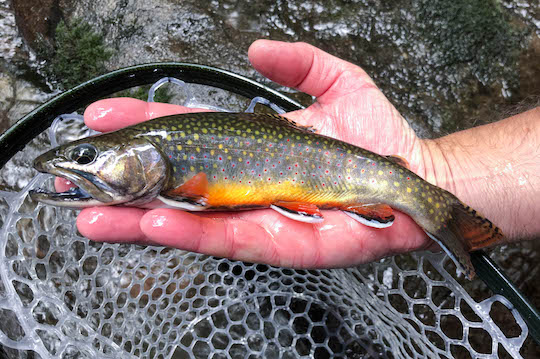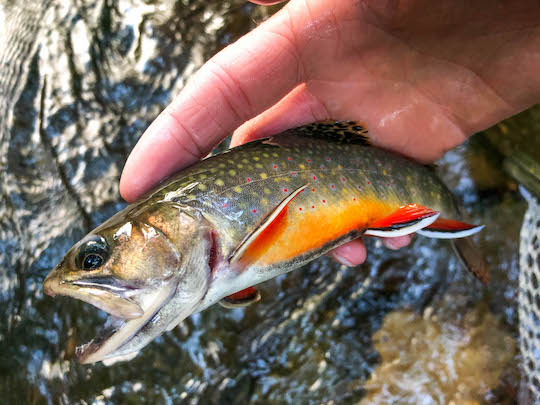Summer is my least favorite season. This is primarily due to the heat and humidity that seems a little worse every year. Maybe I'm just getting older and less tolerant of a variety of weather conditions, but either way, summer isn't my favorite. There are a few redeeming features of the season, however.
First, the long days are fantastic. More light usually equals more energy, at least for me. Need to leave home by 5:00 am for a long day of fishing or guiding? No problem. When I get home later, say 6 pm or after, there is still plenty of light to enjoy a family walk through our neighborhood after eating supper. In the middle of winter, with sunset at 4:30 pm, that just isn't an option. Oh, and the fishing adventures in summer are always a joy. Smallmouth wade trips on the Cumberland Plateau, brook trout excursions in the Great Smoky Mountains, and of course tailwater float trips for large trout.
Yes, summer isn't all bad. However, by sometime in July, I'm usually trying to figure out how to escape the heat and humidity even if for a little while. I can do one or the other, but the combination of both is just miserable. Some years, that escape comes in the form of a trip out west. In other years, my only escape is to the high elevations of the Great Smoky Mountains National Park.
This year, by mid July, I noticed that a particular week of August still had no trips booked. Normally, I would sit tight with the knowledge that eventually some work will come through. That is part of the guide business after all. This summer had been unusually hot, however, and I was ready for a break. After a quick consultation with my wife, we made camping reservations for a favorite campground way up high in the Smokies. Even in the hottest summer months, it is always nice and cool. The humidity would probably be fairly high, but that is the nature of spending time in the temperate rainforest otherwise known as the Great Smoky Mountains.
As our scheduled trip got closer and closer, the weather pattern trended wetter and wetter. It became apparent that at minimum we would see a lot of rain. Such is life in the Smokies in summer where you can expect pop up showers and storms nearly every day at the higher elevations. Thankfully, we had an awning for our picnic table and a large roomy tent that I've had seemingly forever now and is still mostly waterproof.
We arrived at the campground during a lull in the rain chances and got everything set up quickly. After eating supper, some rain showers started to move in and we quickly made tracks for the inside of the tent. The little ones were super excited to get inside the tent and play. Thus, it took longer than usual to calm down for bedtime. Eventually, we all fell asleep to occasional rain showers whispering on the top of the tent.
The next morning started out wet. We had to dry the benches and table top before preparing breakfast. Eventually we got everything dry enough to fix breakfast. By some miracle, the weather cleared a little while we ate, meaning the clouds lifted enough to see more than a few feet. The fog up high in the Smokies is some of the thickest that I've ever seen, but on this morning it lifted enough that we had a window to enjoy what the mountain offered. A nearby trail beckoned with the chance to get a short hike and some fishing in. We hit the trail and all started down the hill. I was carrying a fly rod, hoping for some native brook trout.
Quickly, we began to find interesting wildflowers. I took more pictures than I should share here, at least some of which were firsts for me or at least the first time I bothered to identify them. One of the more interesting is commonly referred to as fly poison (Amianthium muscitoxicum). It is poisonous and affects livestock that consume it to varying degrees including death if large amounts are ingested. Early pioneers would grind the bulb into a powder, mix it with sugar, and set out the potion to kill flies, hence the common name.
 |
| "Fly Poison." ©2025 David Knapp Photography |
There were plenty of other interesting wildflowers, but I had my sight set on brook trout fishing. After a few quick pictures on the way by, I kept trekking down the hill to the stream. Running through a very high elevation valley, this particular stream contains pure southern strain brook trout. When you first see the little trickle, you have doubts as to weather it will contain fish, but sure enough, there are plenty of them swimming these cold waters.
I helped one of the little ones fish and we caught a brook trout. That gave us the opportunity to practice how to hold a trout carefully and respectfully. A few pictures were taken and then we sent the beautiful fish back to its watery home. That routine became the plan for the next thirty minutes or so. Wander and explore further downstream, catching the occasional fish and teaching the little one how to gently handle and release our catch.
 |
| "Brook trout and dry flies, a perfect combo." ©2025 David Knapp Photography |
As we hiked, other interesting things stood out to us. The usual wildflowers kept me looking around, of course, but we also found neat reflections in a forest pool on the trail. The ongoing wet spell had water everything, both flowing and standing. In another spot, the muddy trail had captured the track of a good sized bear that must have wandered through that morning. Anything earlier and the rain would have washed the track away. One section of trail had some beautiful fall colors where an early turning maple had showered the ground with color.
 |
| "Early fall colors." ©2025 David Knapp Photography |
 |
| "Fresh bear track." ©2025 David Knapp Photography |
 |
| "Forest pool." ©2025 David Knapp Photography |
About this time, we realized that lunch time was sneaking up on us. The little ones in particular would need to eat soon, so we reluctantly turned around. I wanted to sample a longer piece of water than I could with them in tow, so I told Mama that I would meet them at the first crossing upstream and started creek walking fast. Several fish later, including one particularly nice one, and I was more and more amazed at how many fish this stream held. Eventually, however, the stream appeared to be running out of a solid wall of rhododendron. Instead of plowing on through, I figured that I better catch up with everyone and jumped back up on the trail.
 |
| "Colorful native brookie." ©2025 David Knapp Photography |
 |
| "Rhododendron wall." ©2025 David Knapp Photography |
When I found them, the kids were getting soaked in the stream having the best time of their lives. Water was splashing and flying everywhere. After a quick cleanup and partial drying, we got everyone moving up the trail again. Upon arriving back at the trailhead, Mama and the littles decided to walk the road back while I took the truck back to the campsite. Wild blackberries were abundant and they wanted a pre lunch snack. I quickly got back, parked, and headed back down the road to find them. They were just about to the campground entrance when I found them. While looking for some blackberries for myself, I found another interesting wildflower and got some pictures.
 |
| "Appalachian bellflower or southern harebell (Campanula divaricata)." ©2025 David Knapp Photography |
About that time, we decided to head back to camp to eat our real lunch. The wild blackberry snacks were delicious, but not particularly filling. We still had the whole afternoon ahead of us but it was threatening rain again. After lunch, the decision was made to head down the mountain. The Oconaluftee area of the Park was a good place to possibly avoid some of the showers in the higher elevations. I was contemplating some more fishing as well, although that part of the plan soon took a back seat. There were more interesting things to see for the Little Ones.
 |
| "Oconaluftee River." ©2025 David Knapp Photography |
Upon arrival at Oconaluftee, we decided to enjoy the old farm behind the visitors center. That proved to be a big hit with the Littles, and we took some pictures to remember the afternoon by. I particularly enjoyed a squirrel that was going crazy feasting in a tree overhanging the walkway and eventually got a good picture of the critter perched upside down, chowing away.
 |
| "Hungry squirrel." ©2025 David Knapp Photography |
Time began to get away from us, and we realized it was time to head back up the mountain. With luck, we might get some supper before the heaviest showers commenced again. On the way back, we briefly spotted a black bear that didn't hang around long enough for pictures. I did stop and get some quick shots of some orange fringed orchids that always bloom in that vicinity.
 |
| "Orange fringed orchid." ©2025 David Knapp Photography |
Back in camp, we got most of our evening routines done while staying reasonably dry, but it was obvious that the rain was setting in for a while. Sleeping in a tent during a good rain is one of my favorite parts of camping, providing of course that the tent doesn't leak. On this evening, we fell asleep to the gentle pitter patter of rain on the tent.
The rain fell on again and off again throughout the night and into the next morning. Finally it broke, and we got up and had breakfast. The Little Ones didn't particularly want to spend a lot of time in their car seats, but I had an idea that might just work. The fog was so thick on the mountain that everything was damp just because of the high humidity. Another drive down the mountain seemed in order. This time, we headed the other direction, towards Cataloochee Valley.
This proved to be another excellent choice. We were on the lee side of the mountains compared to the prevailing flow at the time, so Cataloochee was dry with partly cloudy skies. We saw more sun in Cataloochee than we did the entire rest of the time during our camping trip. A picnic lunch got us all energized for the afternoon. On our drive up the valley, one of the large bull elk posed for a few pictures.
 |
| "Bull elk in Cataloochee Valley." ©2025 David Knapp Photography |
Once we parked, I headed for the stream while Mama and the Little Ones grabbed a blanket and went to play and stretch their legs. I was excited to see Cataloochee Creek, one of my favorites in the Smokies. This was my first time in the Valley after Hurricane Helene, and I was very curious how the creek would look. To all appearances, it was healthy and the fish were all happy. The biggest difference was that some pools had filled in while others had deepened. I fished a favorite piece of water for probably 45 minutes. There were fish just about everywhere I expected to find them. True to recent history, I caught at least as many brook trout as anything else. I also managed one brown trout that also happened to be both my first fish landed and the least cooperative for pictures. By the time I caught back up with the family, I had my first Smokies slam of the year, all on a fun toy. The Redington Butterstick is a favorite for when I just want to have a good time. The fiberglass rod is soft but oh so much fun to fish.
 |
| "Palmer Chapel." ©2025 David Knapp Photography |
 |
| "Fish Flop!" ©2025 David Knapp Photography |
 |
| Buttersticks and brookies." ©2025 David Knapp Photography |
 |
| "Rainbow trout to complete the slam." ©2025 David Knapp Photography |
After catching back up with the family, we headed on up the valley. There, we found significant road damage from Helene, but thankfully all the historic structures were still standing. The barn across the road from the Caldwell place was in fairly rough shape but still standing. I have since heard that the Park received a private donation/grant to restore some of these structures, so hopefully we'll be able to enjoy these structures for many years to come.
 |
| "Caldwell Place." ©2025 David Knapp Photography |
The wildflowers in the upper valley were particularly vibrant. Goldenrod and ironweed were drawing pollinators of all kinds. I took a few pictures that of course couldn't do the scene justice, but captured a few of the pollinators as well which was neat.
 |
| "Ironweed and pollinators." ©2025 David Knapp Photography |
 |
| "Lucky shot of a flying bee with golden rod and ironweed." ©2025 David Knapp Photography |
After getting back to the truck, we decided it was probably time to head back up the mountain for our final night of camping. Sure enough, as we drove that way it began threatening rain. We had one or two more rain showers before departing the next morning. However, we were fortunate that the next morning donned bright and drier than it had been during our whole time camping. Things were dry enough to sufficiently dry a fair amount of our gear and get packed at least without doing so in the pouring rain. It had been another successful and relaxing camping trip. I noticed my back was more sore than usual, reminding me that the ground is getting harder every year, but otherwise it was a great camping trip. This might even have to be added to the yearly routine for every summer moving forward. It is nice to escape the heat, even if for just a little while.














